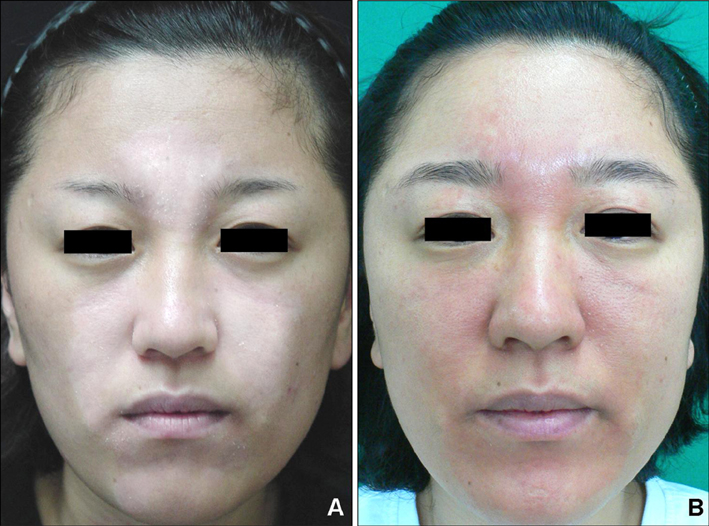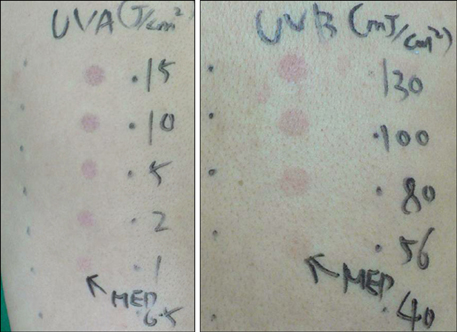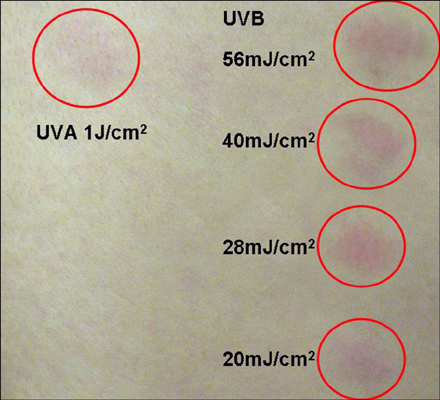Ann Dermatol.
2009 Feb;21(1):88-91. 10.5021/ad.2009.21.1.88.
The Photosensitivity Localized in a Vitiliginous Lesion Was Associated with the Intramuscular Injections of Synthetic Progesterone during an In Vitro Fertilization-embryo Transfer
- Affiliations
-
- 1Department of Dermatology, College of Medicine, Dong-A University, Busan, Korea. khkim@dau.ac.kr
- KMID: 2172077
- DOI: http://doi.org/10.5021/ad.2009.21.1.88
Abstract
- The cutaneous diseases associated with progesterone are autoimmune progesterone dermatitis, erythema multiforme- like eruption, drug-induced progesterone dermatitis and solar urticaria. Estrogen and progesterone are widely used in oral contraceptives and hormone replacement therapies, and they are rarely known to cause a photosensitive reaction. The mechanism of contraceptive-induced photosensitivity is uncertain. Estrogen, rather than progesterone, in the combined oral contraceptive pill has been most frequently implicated in the induction of photosensitivity. A 32-year-old woman presented with an erythematous patch with an itching sensation on the centrofacial area of a residual vitiligious lesion. She had a history of being previously treated with narrow band UVB for 1 year. Her skin lesions had mostly subsided, but some lesions continued. She underwent an in vitro fertilization-embryo transfer 3 months previously, and she then took synthetic progesterone for 3 weeks starting at the 4th week of pregnancy. She was in good health with neither a family history of photosensitivity nor a personal history of any other drug ingestion or topical agent such as sunscreen in association with the beginning of her lesions. Phototesting revealed her to be markedly photosensitive in the UVB and UVA ranges. The intradermal skin reactions to progesterone combined with irradiation with UVA or UVB were positive. We report here on an unusual case of photosensitivity that was localized in a vitiliginous lesion, and this was associated with the intramuscular injections of synthetic progesterone that she had received during an in vitro fertilization-embryo transfer.
MeSH Terms
Figure
Reference
-
1. Baptist AP, Baldwin JL. Autoimmune progesterone dermatitis in a patient with endometriosis: case report and review of the literature. Clin Mol Allergy. 2004. 2:10.2. Cooper SM, George S. Photosensitivity reaction associated with use of the combined oral contraceptive. Br J Dermatol. 2001. 144:641–642.
Article3. Ackroyd J. Vitiligo and photosensitivity. BMJ. 1988. 297:1126.
Article4. Ro KW, Jung JG, Shim SD, Kim MH, Cinn YW. A case of photosensitivity induced by the hormonal replacement agents containing estrogen and progesterone. Korean J Dermatol. 2005. 43:1098–1101.5. Sixel-Dietrich F, Doss M. Hereditary uroporphyrinogen-decarboxylase deficiency predisposing porphyria cutanea tarda (chronic hepatic porphyria) in females after oral contraceptive medication. Arch Dermatol Res. 1985. 278:13–16.
Article6. Hall G, Phillips TJ. Estrogen and skin: the effects of estrogen, menopause, and hormone replacement therapy on the skin. J Am Acad Dermatol. 2005. 53:555–568.
Article7. Elling SV, Powell FC. Physiological changes in the skin during pregnancy. Clin Dermatol. 1997. 15:35–43.
Article
- Full Text Links
- Actions
-
Cited
- CITED
-
- Close
- Share
- Similar articles
-
- Sequential use of Intramuscular and Oral Progesterone for Luteal Phase Support in in vitro Fertilization
- The Effect of Periovulatory Progesterone Supplementation in In Vitro Fertilization and Embryo Transfer Program
- In vitro fertilization and embryo transfer (IVF & ET) in Wonju Christian Hospital
- The clinical study of in vitro fertilization and embryo transfer
- Obstetric Outcomes of Twin Pregnancies after In Vitro Fertilization and Embryo Transfer




